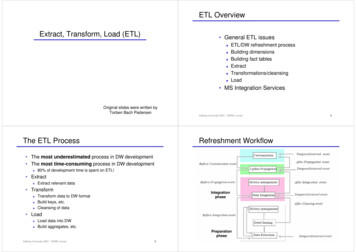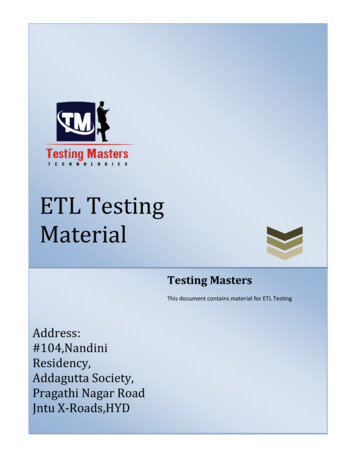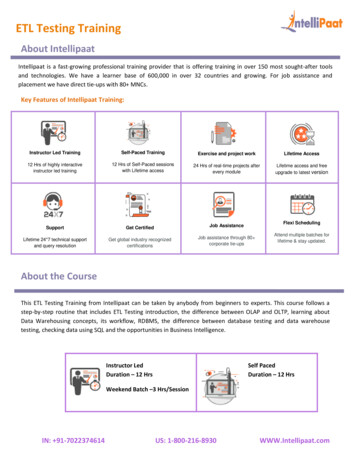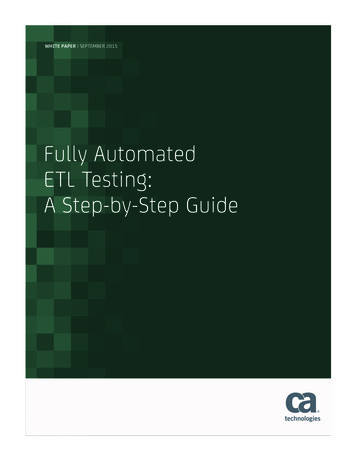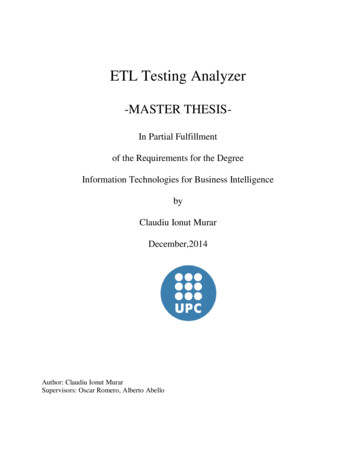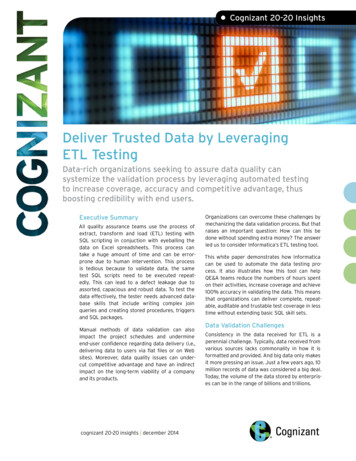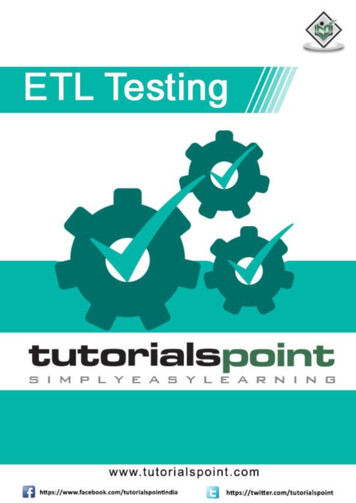
Transcription
ETL TestingAbout the TutorialAn ETL tool extracts the data from all these heterogeneous data sources, transforms thedata (like applying calculations, joining fields, keys, removing incorrect data fields, etc.),and loads it into a Data Warehouse. This is an introductory tutorial that explains all thefundamentals of ETL testing.AudienceThis tutorial has been designed for all those readers who want to learn the basics of ETLtesting. It is especially going to be useful for all those software testing professionals whoare required to perform data analysis to extract relevant information from a database.PrerequisitesWe assume the readers of this tutorial have hands-on experience of handling a databaseusing SQL queries. In addition, it is going to help if the readers have an elementaryknowledge of data warehousing concepts.Disclaimer & Copyright Copyright 2015 by Tutorials Point (I) Pvt. Ltd.All the content and graphics published in this e-book are the property of Tutorials Point(I) Pvt. Ltd. The user of this e-book is prohibited to reuse, retain, copy, distribute orrepublish any contents or a part of contents of this e-book in any manner without writtenconsent of the publisher.We strive to update the contents of our website and tutorials as timely and as preciselyas possible, however, the contents may contain inaccuracies or errors. Tutorials Point (I)Pvt. Ltd. provides no guarantee regarding the accuracy, timeliness or completeness ofour website or its contents including this tutorial. If you discover any errors on ourwebsite or in this tutorial, please notify us at contact@tutorialspoint.comi
ETL TestingTable of ContentsAbout the Tutorial . iAudience . iPrerequisites . iDisclaimer & Copyright. iTable of Contents . ii1.ETL – INTRODUCTION . 1Difference between ETL and BI Tools . 1ETL Process . 2ETL Tool Function . 32.ETL TESTING – TASKS . 43.ETL VS DATABASE TESTING . 54.ETL TESTING – CATEGORIES. 75.ETL TESTING – CHALLENGES . 96.ETL – TESTER'S ROLES . 107.ETL TESTING – TECHNIQUES . 128.ETL TESTING – PROCESS . 159.ETL TESTING – SCENARIOS (TEST CASES) . 1610. ETL TESTING – PERFORMANCE . 1911. ETL TESTING – SCALABILITY . 2012. ETL TESTING – DATA ACCURACY . 2113. ETL TESTING – METADATA . 22ii
ETL Testing14. ETL TESTING – DATA TRANSFORMATIONS . 2315. ETL TESTING – DATA QUALITY . 2416. ETL TESTING – DATA COMPLETENESS. 2517. ETL TESTING – BACKUP RECOVERY . 2618. ETL TESTING – AUTOMATION . 2719. ETL TESTING – BEST PRACTICES . 2820. ETL TESTING – INTERVIEW QUESTIONS . 30iii
1. ETL – IntroductionETL TestingThe data in a Data Warehouse system is loaded with an ETL (Extract, Transform, Load)tool. As the name suggests, it performs the following three operations: Extracts the data from your transactional system which can be an Oracle,Microsoft, or any other relational database, Transforms the data by performing data cleansing operations, and then Loads the data into the OLAP data Warehouse.You can also extract data from flat files like spreadsheets and CSV files using an ETL tooland load it into an OLAP data warehouse for data analysis and reporting. Let us take anexample to understand it better.ExampleLet us assume there is a manufacturing company having multiple departments such assales, HR, Material Management, EWM, etc. All these departments have separatedatabases which they use to maintain information w.r.t. their work and each databasehas a different technology, landscape, table names, columns, etc. Now, if the companywants to analyze historical data and generate reports, all the data from these datasources should be extracted and loaded into a Data Warehouse to save it for analyticalwork.An ETL tool extracts the data from all these heterogeneous data sources, transforms thedata (like applying calculations, joining fields, keys, removing incorrect data fields, etc.),and loads it into a Data Warehouse. Later, you can use various Business Intelligence (BI)tools to generate meaningful reports, dashboards, and visualizations using this data.Difference between ETL and BI ToolsAn ETL tool is used to extract data from different data sources, transform the data, andload it into a DW system; however a BI tool is used to generate interactive and ad-hocreports for end-users, dashboard for senior management, data visualizations formonthly, quarterly, and annual board meetings.The most common ETL tools include: SAP BO Data Services (BODS), Informatica –Power Center, Microsoft – SSIS, Oracle Data Integrator ODI, Talend Open Studio, CloverETL Open source, etc.Some popular BI tools include: SAP Business Objects, SAP Lumira, IBM Cognos,JasperSoft, Microsoft BI Platform, Tableau, Oracle Business Intelligence EnterpriseEdition, etc.1
ETL TestingETL ProcessLet us now discuss in a little more detail the key steps involved in an ETL procedure –Extracting the DataIt involves extracting the data from different heterogeneous data sources. Dataextraction from a transactional system varies as per the requirement and the ETL tool inuse. It is normally done by running scheduled jobs in off-business hours like runningjobs at night or over the weekend.Transforming the DataIt involves transforming the data into a suitable format that can be easily loaded into aDW system. Data transformation involves applying calculations, joins, and definingprimary and foreign keys on the data. For example, if you want % of total revenue whichis not in database, you will apply % formula in transformation and load the data.Similarly, if you have the first name and the last name of users in different columns,then you can apply a concatenate operation before loading the data. Some data doesn’trequire any transformation; such data is known as direct move or pass through data.Data transformation also involves data correction and cleansing of data, removingincorrect data, incomplete data formation, and fixing data errors. It also includes dataintegrity and formatting incompatible data before loading it into a DW system.Loading the Data into a DW SystemIt involves loading the data into a DW system for analytical reporting and information.The target system can be a simple delimited flat file or a data warehouse.2
ETL TestingETL Tool FunctionA typical ETL tool-based data warehouse uses staging area, data integration, and accesslayers to perform its functions. It’s normally a 3-layer architecture. Staging Layer – The staging layer or staging database is used to store the dataextracted from different source data systems. Data Integration Layer – The integration layer transforms the data from thestaging layer and moves the data to a database, where the data is arranged intohierarchical groups, often called dimensions, and into facts and aggregatefacts. The combination of facts and dimensions tables in a DW system is called aschema. Access Layer – The access layer is used by end-users to retrieve the data foranalytical reporting and information.The following illustration shows how the three layers interact with each other.3
2. ETL Testing – TasksETL TestingETL testing is done before data is moved into a production data warehouse system. It issometimes also called as table balancing or production reconciliation. It is differentfrom database testing in terms of its scope and the steps to be taken to complete this.The main objective of ETL testing is to identify and mitigate data defects and generalerrors that occur prior to processing of data for analytical reporting.ETL Testing – Tasks to be PerformedHere is a list of the common tasks involved in ETL Testing –1. Understand the data to be used for reporting2. Review the Data Model3. Source to target mapping4. Data checks on source data5. Packages and schema validation6. Data verification in the target system7. Verification of data transformation calculations and aggregation rules8. Sample data comparison between the source and the target system9. Data integrity and quality checks in the target system10. Performance testing on data4
3. ETL vs Database TestingETL TestingBoth ETL testing and database testing involve data validation, but they are not thesame. ETL testing is normally performed on data in a data warehouse system, whereasdatabase testing is commonly performed on transactional systems where the data comesfrom different applications into the transactional database.Here, we have highlighted the major differences between ETL testing and Databasetesting.ETL TestingETL testing involves the following operations:1. Validation of data movement from the source to the target system.2. Verification of data count in the source and the target system.3. Verifying data extraction, transformation as per requirement and expectation.4. Verifying if table relations – joins and keys – are preserved during thetransformation.Common ETL testing tools include QuerySurge, Informatica, etc.Database TestingDatabase testing stresses more on data accuracy, correctness of data and valid values.It involves the following operations:1. Verifying if primary and foreign keys are maintained.2. Verifying if the columns in a table have valid data values.3. Verifying data accuracy in columns. Example: Number of months columnshouldn’t have a value greater than 12.4. Verifying missing data in columns. Check if there are null columns which actuallyshould have a valid value.Common database testing tools include Selenium, QTP, etc.5
ETL TestingEnd of ebook previewIf you liked what you saw Buy it from our store @ https://store.tutorialspoint.com6
The main objective of ETL testing is to identify and mitigate data defects and general errors that occur prior to processing of data for analytical reporting. ETL Testing – Tasks to be Performed Here is a list of the common tasks involved in ETL Testing – 1. Understand the data to be used for reporting 2. Review the Data Model 3. Source to target mapping 4. Data checks on source data
